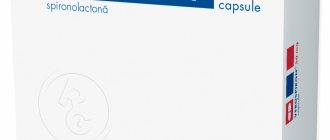Instructions for use of OCTAGAM® (OCTAGAM)
The drug contains 100 mg of maltose per 1 ml as an excipient. Maltose interference in blood glucose tests may result in elevated glucose values and therefore inappropriate insulin administration, which can lead to life-threatening hypoglycemia and death. In addition, cases of true hypoglycemia may go untreated if the hypoglycemic state is masked by an elevated glucose value.
Octagam® 5% contains maltose, a disaccharide obtained from cereals. Anaphylactoid/anaphylactic reactions have been reported in association with the infusion of other maltose/corn starch related products. Patients allergic to cereals should either avoid the use of Octagam® 5% or be closely monitored for signs and symptoms of acute hypersensitivity reactions.
The occurrence of some severe side effects may be related to the rate at which the drug is administered. The recommended rate of administration must be strictly observed. During drug administration, the patient's condition and the occurrence of any symptoms should be monitored throughout the entire period of drug administration.
The most common adverse reactions that may occur are:
- at a high rate of administration;
- when administering immunoglobulin for the first time or, in rare cases, when switching to another immunoglobulin or after a long time has passed since the last infusion.
Potential complications can be avoided by ensuring that patients:
- are not sensitive to normal human immunoglobulin, for which purpose the drug is administered slowly, at a rate of 1 ml/kg/h;
- Monitored closely by staff for any symptoms throughout the infusion period. This is especially true for patients who have not previously received immunoglobulin preparations; patients who previously received normal human immunoglobulin from another manufacturer and switched to the administration of the drug Octagam® 5%; as well as those patients who have a long break after the last immunoglobulin infusion. Such patients require constant monitoring throughout the entire period of the first infusion, as well as for 1 hour after its completion. Other patients should be observed for at least the first 20 minutes of infusion.
If an undesirable side effect occurs, the rate of drug administration should be reduced or the infusion should be stopped. The treatment needed depends on the nature and severity of the adverse reaction.
In case of shock, standard anti-shock medical treatment should be applied.
When using immunoglobulins for intravenous administration in all patients, the following is required:
- providing adequate hydration before starting the infusion;
- diuresis control;
- control of serum creatinine levels;
- avoid concomitant use of loop diuretics.
Octagam® 5% contains no more than 0.015 mmol (or 0.35 mg) sodium per 1 ml. This should be taken into account in patients on a controlled sodium diet.
Hypersensitivity
True hypersensitivity reactions are rare. They can occur in patients with antibodies to IgA.
IVIG is not indicated for patients with selective IgA deficiency, when IgA deficiency is the only disorder.
In rare cases, the use of human normal immunoglobulin can cause a sharp decrease in blood pressure with an anaphylactic reaction, even in patients who have tolerated previous treatment with human normal immunoglobulin.
Thromboembolism
There is clinical evidence that the administration of immunoglobulin in high doses can lead to an increase in the viscosity of the blood plasma in patients at risk, which increases the risk of ischemia and thromboembolic complications such as myocardial infarction, stroke, pulmonary embolism and deep vein thrombosis, which, as believed to be associated with a relative increase in blood viscosity due to the intake of large amounts of immunoglobulin. Caution should be exercised when prescribing and administering Octagama® 5% to patients with obesity and pre-existing risk factors for thrombosis (for example, advanced age, hypertension, diabetes mellitus, history of vascular disease or thrombotic complications, acquired or hereditary thrombophilic disorders, prolonged immobilization, severe hypovolemia, diseases that increase blood viscosity).
In patients at risk of thromboembolic adverse reactions, IVIG drugs should be used at the minimum infusion rate and dose possible.
Acute renal failure
Cases of acute renal failure have been reported in patients receiving IVIG therapy. In most cases, risk factors have been established (eg, pre-existing renal failure, diabetes mellitus, age over 65 years, hypovolemia, excess weight, or concomitant use of nephrotoxic drugs).
In case of renal failure, discontinuation of IVIG should be considered. Although in these reports, renal dysfunction and acute renal failure were associated with the use of many of the licensed IVIG products containing sucrose, glucose, and maltose as excipients, products containing sucrose accounted for a disproportionately large proportion of the total. In patients at risk, the use of IVIG products that do not contain sucrose should be considered. Octagam® 5% contains maltose.
In patients at risk for adverse reactions of acute renal failure, IVIG drugs should be used at the minimum infusion rate and the lowest possible dose.
Aseptic meningitis syndrome (ASM)
Aseptic meningitis syndrome has been reported in association with IVIG treatment. Discontinuation of IVIG treatment resulted in remission of MAS within a few days without complications. The syndrome usually occurs within a few hours to 2 days after IVIG treatment. In the cerebrospinal fluid, pleocytosis of up to several thousand cells per mm3, predominantly of the granulocytic series, and an increase in protein content up to several hundred mg/dl are often observed.
More often, SAM may occur in association with a high dose (2 g/kg) of IVIG.
Hemolytic anemia
IVIG products may contain blood group antibodies that can act as hemolysins and cause in vivo coating of red blood cells with immunoglobulin, leading to a positive direct antiglobulin reaction (Coombs test) and, less commonly, hemolysis. Hemolytic anemia may develop after IVIG treatment due to increased red blood cell sequestration. IVIG recipients should be monitored for clinical signs and symptoms of hemolysis. The content of anti A- and anti B-hemmaglutinins is <64 in Octagam® 5%.
Impact on serological test results
After administration of immunoglobulin, a transient increase in various passively transferred antibodies in the patient's blood can lead to false-positive results of serological tests.
Passive transfer of antibodies to red blood cell antigens (eg, A, B, or D) may alter the results of some red blood cell antibody serologic tests (eg, DAT, direct Coombs test).
Infectious agents
Standard measures aimed at preventing infections resulting from the use of medicinal products prepared from human blood or plasma include selecting healthy donors, testing each portion of plasma and plasma pools for the presence of specific markers of infection; and incorporating effective virus removal/inactivation procedures into the manufacturing process, including solvent-detergent viral inactivation and pH 4.0 incubation. Despite this, when using drugs made from human blood or plasma, the possibility of contracting infectious diseases cannot be completely excluded. This also applies to infectious agents of unknown origin or new viruses and other pathogens.
These measures are considered effective for enveloped viruses such as HIV, HBV (hepatitis B virus) and HCV (hepatitis C virus).
The effectiveness of measures may be limited against non-enveloped viruses such as HAV (hepatitis A virus) and parvovirus B19.
There is encouraging clinical experience indicating that there is no risk of transmission of infectious pathogens hepatitis A and parvovirus B19 when administered immunoglobulins. It is also assumed that antibody content contributes significantly to viral safety.
Whenever Octagam® 5% is administered to a patient, it is strongly recommended to register the name of the drug and the batch number of the drug in order, if necessary, to establish a connection between the patient’s condition and the use of a specific batch of the drug.
Acute post-transfusion lung injury (TRALI)
There have been reports of non-cardiogenic pulmonary edema [Transfusion Acute Lung Injury (TRALI)] in patients receiving IVIG therapy, so this side effect cannot be completely excluded for Octagam 5%, but no cases have been found with the drug to date Octagam® 5%. TRALI is characterized by severe respiratory distress, pulmonary edema, hypoxemia, normal left ventricular function, fever, and usually occurs within 1 to 6 hours after transfusion.
(False) increased erythrocyte sedimentation rate
In patients receiving IVIG therapy, the erythrocyte sedimentation rate (ESR) may be falsely elevated (non-inflammatory increase).
Volume overload
Volume overload can occur when the volume of IVIG (or any other blood or plasma-derived product) administered and other accidental infusions cause hypervolemia and acute pulmonary edema.
Local reactions at the injection site
Local reactions at the injection site have been identified and may include bruising, injection site erythema, injection site itching, and similar symptoms.
Use in pediatrics
There are no specific or additional warnings or precautions for use in pediatric patients.
Special handling precautions
The drug should not be warmed to room temperature or body temperature before use.
The solution should be clear or slightly opalescent, colorless or slightly yellow.
Solutions that are cloudy or contain inclusions should not be used.
Due to the possibility of bacterial contamination, any remaining contents should be discarded.
Any unused product or waste material should be disposed of in accordance with local regulations.
Impact on the ability to drive vehicles and operate machinery
The ability to drive vehicles and operate machinery may be reduced as a result of some adverse reactions associated with Octagam® 5%. Patients who experience adverse reactions during treatment should wait until they resolve before driving or operating machinery.
Octagam® 10% (Octagam® 10%)
Due to the fact that the development of some side effects may be associated with the speed of administration of the drug, the instructions should be strictly followed. During administration of the drug, the patient's condition should be carefully monitored.
For all patients receiving intravenous immunoglobulins, it is necessary to provide adequate hydration before starting the infusion, monitor diuresis, monitor plasma creatinine concentrations, and avoid the use of loop diuretics.
If side effects occur, the rate of administration of the drug should be reduced or stopped completely. Treatment depends on the nature and severity of the side effect. In case of shock, antishock treatment should be initiated in accordance with current standards of care.
Most often, adverse reactions can occur at a high rate of administration, with hypo- and agammaglobulinemia (with or without immunoglobulin A deficiency), when administering immunoglobulin for the first time, in rare cases - when transferring to the administration of immunoglobulin from another manufacturer, or after a long period of time. period of time since the last infusion. Such patients should be observed throughout the entire period of the first infusion of the drug, as well as for 1 hour after the end of administration. Other patients should be observed during the first 20 minutes of infusion. Standard measures to prevent infections caused by the use of medicinal products derived from human blood or plasma include screening donors, testing individual portions and pools of plasma for specific markers of infection, and incorporating effective virus inactivation/elimination measures into the manufacturing process. However, the possibility of transmission of infectious disease agents cannot be completely excluded. This also applies to unknown or newly identified viruses and other pathogens. These measures are considered effective against the enveloped viruses HIV, hepatitis B and hepatitis C, and to a lesser extent against hepatitis A virus and parvovirus B19. Growing clinical experience with human immunoglobulin preparations strongly suggests that hepatitis A virus and parvovirus B19 are not transmitted during treatment with these drugs. The presence of appropriate antibodies in the drug plays a major role in ensuring antiviral safety. During the treatment period, a transient increase in various passively transferred antibodies in the patient's blood can lead to false-positive results of serological tests. Passive transfer of antibodies to red cell antigens (eg, A, B, D) may interfere with some serological tests with red cell allo-antibodies (eg, Coombs test).
Due to the presence of maltose (90 mg/ml) in the drug, a false-positive increase in the concentration of glucose in the patient’s blood, determined using some test kits (for example, based on the enzyme glucose dehydrogenase-pyrroloquinoline quinone or using the glucose-dioxyreductase reaction) is possible. . Elevated blood glucose concentrations are determined during the period of drug administration and within 15 hours after its completion. In this regard, unjustified prescription of insulin is possible and, as a consequence, the development of hypoglycemia. This false-positive result may also mask existing hypoglycemia, preventing the patient from receiving appropriate therapy. Thus, when using Octagam® 10%, as when using other parenteral solutions containing maltose, glucose-specific methods for determining blood glucose should be used. Therefore, when studying the instructions for the test kit (including test strips) for determining the concentration of glucose in the blood, you should pay special attention to the possibility of its use in patients receiving medications containing maltose.
During the shelf life, the drug can be stored at temperatures up to 25°C for 3 months without repeated placement in the refrigerator. Any medication not used during this time should be destroyed.
The drug does not have any effect on the ability to drive a car or perform work that requires increased concentration and psychomotor reaction.
Octagam solution d/inf 5% fl 50ml
Compound
Active substance: human plasma proteins - 50 mg, incl. immunoglobulin G not less than 95%. Excipients: maltose - 100 mg, tri-n-butyl phosphate - no more than 1 mcg, octoxynol (Triton X-100) - no more than 5 mcg, water for injection - up to 1 ml.
Pharmacokinetics
After intravenous administration, the drug immediately enters the systemic circulation and is relatively quickly redistributed between plasma and extravascular space. The equilibrium state is achieved after 3-5 days. The half-life is approximately 24-36 days; the half-life may vary between patients, especially those suffering from primary immunodeficiency. Immunoglobulin and immunoglobulin G-complexes are destroyed by cells of the reticuloendothelial system.
Indications for use
- Congenital immunodeficiency conditions (congenital complete or partial immunodeficiency, variant immunodeficiency, severe combined immunodeficiency, Wiskott-Aldrich syndrome); idiopathic thrombocytopenic purpura (especially acute forms in children).
- Acquired immunodeficiency (chronic lymphocytic leukemia, AIDS in children, bone marrow transplantation and other types of transplantations); Kawasaki syndrome (as an adjunct to acetylsalicylic acid therapy); prevention and therapy of infectious diseases.
Contraindications
Intolerance or hypersensitivity to homologous immunoglobulins, especially in extremely rare cases of immunoglobulin A deficiency, when the patient has antibodies to immunoglobulin A.
With caution: pregnancy, lactation.
Directions for use and doses
Before administration, the temperature of the solution should be brought to room temperature or the patient's body temperature.
Solutions that are cloudy or contain sediment should not be used. Any amount of drug remaining after the infusion should be destroyed.
OCTAGAM should not be mixed with other drugs; a separate system for intravenous administration should be used for its administration.
The drug is administered intravenously at an initial rate of 1 ml/kg/hour for 30 minutes. If no adverse reactions were noted, the rate of administration can be gradually increased to a maximum of 5 ml/kg/hour.
Doses and duration of therapy are selected individually, depending on the indication and pharmacokinetic parameters in a particular patient. The following dosages can be used as a recommendation:
Replacement therapy for primary immunodeficiencies:
The administration regimen should help achieve a steady-state level of immunoglobulin G in the range of 4.0-6.0 mg/ml when measured before each subsequent infusion. This requires 3 to 6 months from the start of treatment. The recommended initial dose is 0.4-0.8 g/kg body weight depending on the circumstances (eg acute infection), followed by 0.2 g/kg body weight every 3 weeks. The dose required to achieve a level of 6.0 g/l is from 0.2 to 0.8 g/kg body weight per month. The interval between administrations when a stable level is reached is from 2 to 4 weeks. To most accurately determine administered doses and dosing intervals, periodic measurement of immunoglobulin G levels is recommended.
Replacement therapy for myeloma or chronic lymphoid leukemia with severe secondary hypogammaglobulinemia and recurrent infections; in children with congenital HIV infection and recurrent infections:
The recommended dose is 0.2-0.4 g/kg body weight every 3-4 weeks.
Idiopathic thrombocytopenic purpura (ITP):
in the treatment of acute episodes - 0.8 - 1.0 g/kg body weight on the first day, with repeated administration, if necessary, on the third day or 0.4 g/kg body weight per day for 2-5 days. Treatment can be repeated if the episode occurs again.
Guillain-Barre syndrome:
0.4 g/kg body weight per day, for 3-7 days.
Kawasaki disease:
1.6-2.0 g/kg body weight is administered in equal doses over 2-5 days or a single dose of 2.0 g/kg body weight.
Patients should take aspirin at the same time. Bone marrow transplantation:
immunoglobulin is used as a component of preparatory therapy, as well as after transplantation. Doses of the drug are selected individually. The recommended starting dose is 0.5 g/kg body weight per week. Treatment is continued for 3 months after transplantation.
Storage conditions
Store at temperatures from +2 °C to +25 °C, protected from light.
Do not freeze. Keep out of the reach of children.
Best before date
2 years. Do not use after the expiration date stated on the package.
special instructions
A temporary increase in the content of injected antibodies in the patient’s blood after the administration of Ig may cause false-positive results of serological tests.
Do not exceed the recommended rate of drug administration (serious side effects are likely to develop). During the entire period of infusion and 20 minutes after it, the patient should be under medical supervision.
Description
Immunological drug. Immunoglobulin.
Dosage form
The solution for infusion is clear or slightly opalescent, colorless to light yellow.
Use in children
Use is possible according to indications and in accordance with the dosage regimen.
Pharmacodynamics
Human Ig, replenishing antibody deficiency, reduces the risk of developing infections in patients with primary and secondary immunodeficiency.
Side effects
With intravenous administration of immunoglobulin, the development of side effects depends on the dose size and rate of administration of the drug.
The incidence of adverse reactions is classified as follows: often (≥1% - <10%), uncommon (≥0.1% - <1%), rare (≥0.01% - <0.1%), very rare ( <0.01%).
From the blood and lymphatic system: very rarely - leukopenia, transient hemolytic anemia, hemolysis.
From the immune system: often - hypersensitivity reactions; very rarely - anaphylactoid and anaphylactic (including anaphylactic shock) reactions, angioedema, facial swelling.
From the nervous system: often - headache; very rarely - excitement,
From the cardiovascular system: rarely - hypotension; very rarely - myocardial infarction, tachycardia, palpitations, cyanosis, thrombosis, peripheral circulatory failure, hypertension.
From the respiratory system: very rarely - respiratory failure, pulmonary embolism, pulmonary edema, bronchospasm, shortness of breath, cough.
From the gastrointestinal tract: often - nausea; very rarely - vomiting, diarrhea, abdominal pain.
From the skin: infrequently - eczema; very rarely - urticaria, rash (including erythematous), dermatitis, itching, alopecia.
From the musculoskeletal system: infrequently - back pain; very rarely - arthralgia, myalgia.
From the urinary system: very rarely - acute renal failure, increased concentration of creatinine in the blood.
From laboratory parameters: very rarely - increased values of liver enzymes/false-positive increase in blood glucose concentration.
Other: often - fever, fatigue, reactions at the injection site; infrequently - chills, chest pain; very rarely - flushing of the face, hyperthermia, hyperhidrosis, malaise. Rarely, a sudden decrease in blood pressure may develop, and in some cases, anaphylactic shock, including in patients who previously tolerated the administration of immunoglobulin well.
Use during pregnancy and breastfeeding
Clinical trials on the safety of the drug in pregnant women have not been conducted (therefore it should be used with caution), however, clinical experience with the use of immunoglobulins proves that their administration does not have any negative effect on the course of pregnancy, the fetus and the newborn.
Immunoglobulins are excreted in breast milk, and antibodies may have a protective effect in the newborn.
Interaction
Reduces the activity of attenuated live vaccines against measles, rubella, mumps, chickenpox (when administered in the first 2 weeks after vaccination against measles, mumps and rubella, vaccinations with these vaccines should be repeated no earlier than 3 months later).
Overdose
Symptoms: water retention in the body, increased blood viscosity (especially in patients with impaired renal function or in old age).
Treatment: symptomatic.
Impact on the ability to drive vehicles and operate machinery
Does not have any effect on the ability to drive a car or perform work that requires increased concentration and psychomotor reaction.



